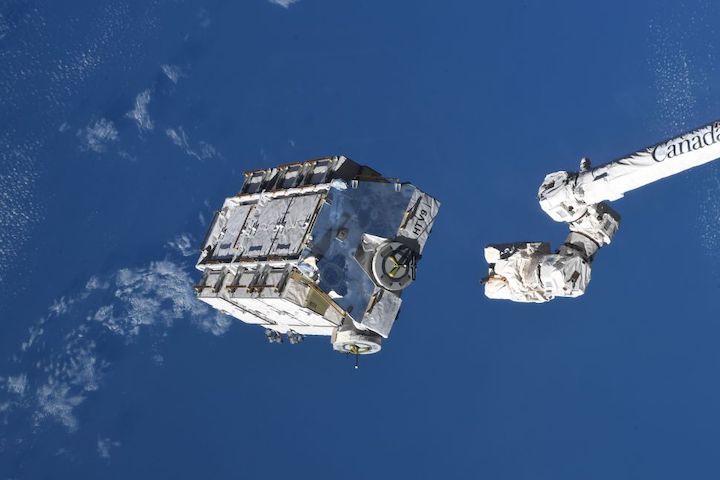18.03.2021
The SUV-sized pallet of old batteries is the most massive object the station has ever jettisoned.

The International Space Station jettisons a 2.9-ton pallet carrying used batteries on March 11, 2021. This photo was posted on Twitter by NASA astronaut Mike Hopkins. (Image credit: NASA/Mike Hopkins via Twitter)
The International Space Station got a little lighter last week.
The orbiting lab discarded a 2.9-ton (2.6 metric tons) pallet of used batteries on Thursday morning (March 11) — the most massive object it has ever jettisoned, NASA spokesperson Leah Cheshier told Gizmodo.
The space junk is expected to fall back to Earth in two to four years, agency officials wrote in an update last week. That update also stated that the pallet will burn up "harmlessly in the atmosphere," but not everyone is convinced that's the case.
"This strikes me (haha, a pun given the circumstances) as dangerous. It seems big and dense so unlikely to burn up completely," astronomer and author Phil Plait, whose "Bad Astronomy" blog runs on Syfy Wire, wrote on Twitter Thursday.
"Yes. On the other hand e.g. Tiangong-1 was 7500 kg [kilograms], much bigger. But I would say given how dense EP9 is, it's concerning, albeit at the low end of concerning," responded astronomer and satellite Jonathan McDowell, who's based at the Harvard-Smithsonian Center for Astrophysics in Cambridge, Massachusetts.
Tiangong-1 was China's first prototype space station, which hosted astronaut crews in 2012 and 2013. The school-bus-sized craft ended up crashing back to Earth over the southern Pacific Ocean in April 2018.
EP9, short for "Exposed Pallet 9," is the recently jettisoned object. EP9 came to the station last year on a Japanese H-II Transfer Vehicle (HTV), as part of the effort to replace the orbiting lab's old nickel-hydrogen batteries with new lithium-ion ones — an extended process that has required a number of spacewalks over the past five years.
Previously, the old batteries were packed into the disposable HTV, which carried them down to their doom in Earth's atmosphere. But the October 2018 launch failure of a Soyuz rocket carrying NASA astronaut Nick Hague and cosmonaut Alexey Ovchinin disrupted this pattern, Spaceflight Now reported. (Hague and Ovchinin ended up landing safely, thanks to their Soyuz capsule's launch-abort system.) And EP9 came up on the ninth and final HTV, meaning it was left without a doomsday ride.
So space station managers decided to jettison the battery-packed pallet. On Thursday morning, ground controllers at NASA's Johnson Space Center in Houston commanded the orbiting lab's 57.7-foot-long (17.6 meters) robotic arm to release EP9 into orbit, NASA officials wrote in the update.
The SUV-sized pallet has plenty of space-junk company up there. According to the European Space Agency, researchers estimate that Earth orbit is cluttered with about 34,000 debris objects at least 4 inches (10 centimeters) wide and 128 million pieces that are 1 millimeter across or larger.
Quelle: SC

